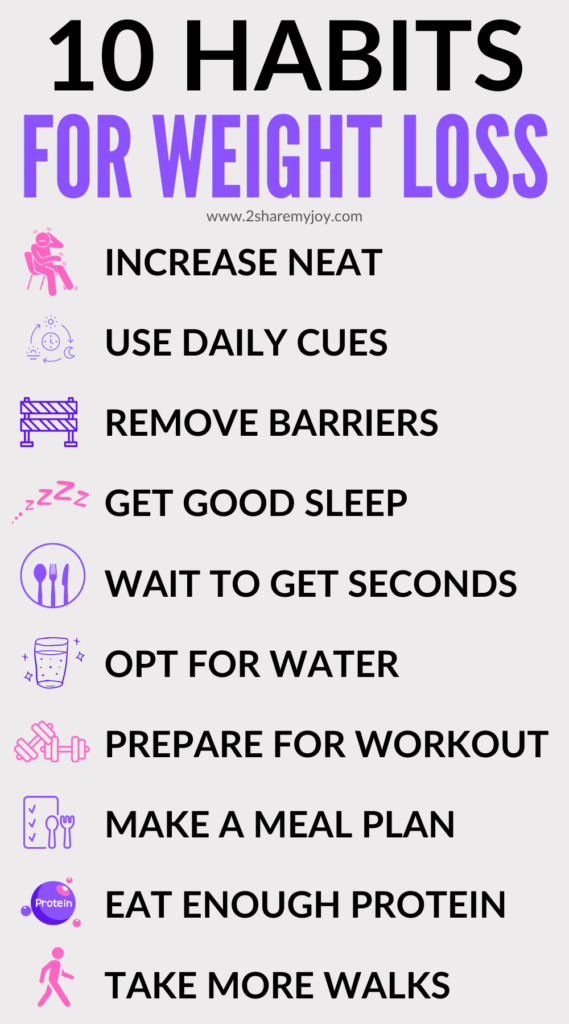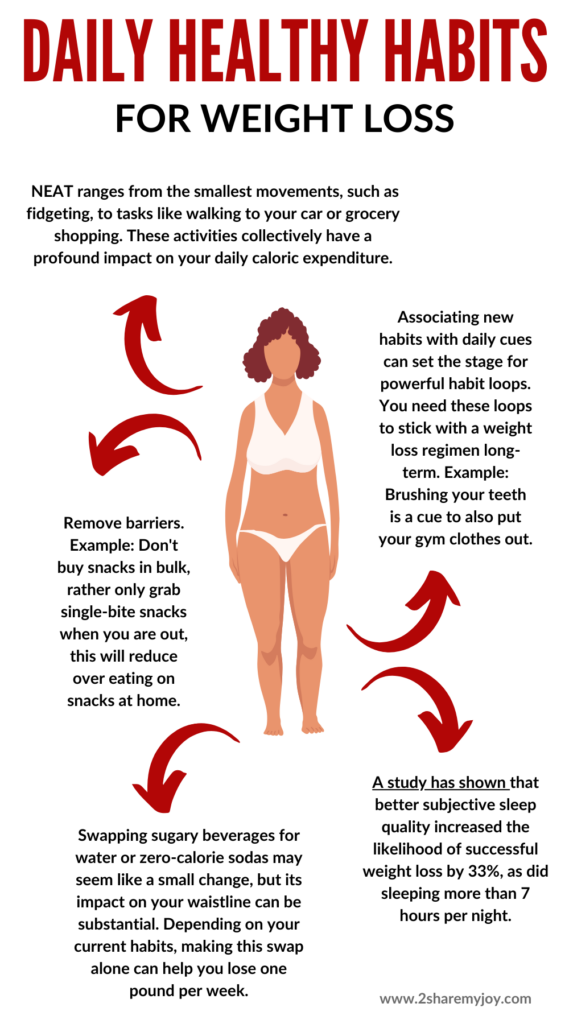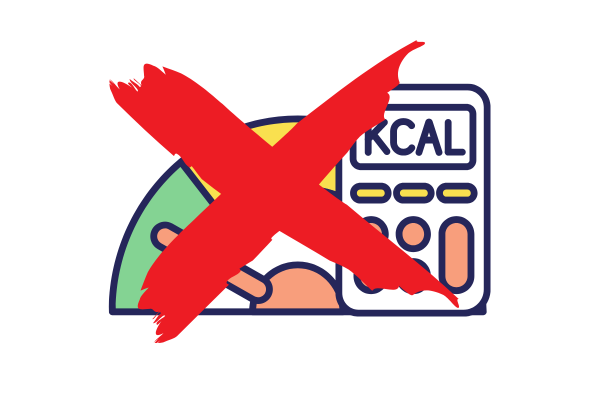10 Habits for Weight Loss on Autopilot
This article explores a holistic approach to weight loss by combining healthy habits with daily cues, addressing barriers that hinder habit formation, emphasizing the importance of quality sleep, and promoting mindful eating practices.
Additionally, it provides practical tips on staying hydrated, preparing for workouts, making meal plans, ensuring an adequate protein intake, and incorporating short walks into your routine.
Small lifestyle changes, such as opting for stairs over elevators or standing during phone calls, can contribute to increased calorie burn without requiring extra time for workouts.

Habits for Weight Loss
By implementing these strategies and embracing a mindset that values consistency over intensity, you can create a seamless routine that supports your weight loss goals.
Remember, the journey to a healthier, lighter you is built on small, sustainable changes that become ingrained habits over time.
Increase NEAT
NEAT stands for Non-Exercise Activity Thermogenesis. It encompasses the calories you burn through daily activities, excluding exercise, eating, or sleeping. NEAT ranges from the smallest movements, such as fidgeting, to tasks like walking to your car or grocery shopping.
It may seem trivial, but these activities collectively have a profound impact on your daily caloric expenditure.
Boosting your NEAT can be simple and requires no gym membership or structured exercise program. Consider walking around while taking phone calls or opting for stairs over elevators.
Park further from the store entrance or pace while waiting. These choices increase your calorie burn without demanding extra time for workouts.
You have countless opportunities to elevate your NEAT throughout the day. Each step taken, every load of laundry carried, and each time you tidy up, calories are burned.
It’s just about being mindful of movements and seizing the chance to be active. Turn routine tasks into calorie-burning opportunities and watch the impact it has on your waistline.
Combine Healthy Habits With Daily Cues
Associating new habits with daily cues can set the stage for powerful habit loops. You need these loops to stick with a weight loss regimen long-term. Think about your morning alarm.
Instead of hitting snooze, use that sound as a cue to stretch for a few minutes. This action wakes the body gently and can boost your metabolism right from the start.
Brushing your teeth is something you do without fail. Pair it with setting out your workout clothes for the day. This simple act primes you to prioritize exercise. Now, every time the minty freshness hits, your brain connects it with fitness readiness.
Here’s a tip: make breakfast prep the night before your signal for planning a healthy lunch. As you wrap up dinner, take a moment to pack a nutritious lunch for the next day.
Not only does this reinforce healthy eating but also saves precious morning time. By linking these actions, you build a chain of habits that naturally flow into one another, creating a seamless routine that supports your weight loss goals.
Remove Any Barriers That Hinder Creating Healthy Habits
Creating new habits for weight loss is challenging when everyday obstacles stand in your path. A cluttered kitchen, inconvenient workout times, or lack of healthy food options can derail your efforts.
Start by tidying your space to make room for meal prep and healthy snacks. Rearrange your schedule to carve out time for exercise, even if it’s just a brisk walk.
Stock your pantry with nutritious ingredients and keep them within easy reach. Prioritizing these simple changes paves the way for a smoother journey to weight loss.
Don’t buy snacks in bulk, rather only grab single-bite snacks when you are out, this will reduce over eating on snacks at home.
Get Good Sleep
A restful night’s sleep can be a powerful ally in your weight loss journey. Your body repairs itself and regulates hormones responsible for appetite during sleep. Less sleep may disrupt these processes, leading to increased hunger and potential weight gain.
Establishing a regular sleep schedule aligns your internal clock, promoting deeper, more refreshing sleep each night. By sleeping well, you not only bolster your body’s fat-burning capabilities but also prime your mind for better decision-making regarding food and exercise.
Your efforts to lose weight gain momentum if you commit to quality sleep. Aim for 7-9 hours each night, ensuring your body gets the rest it needs. Prep your sleep environment for optimum rest—keep your room dark, cool, and free from distractions. Remember, a well-rested you is better equipped to face the day’s challenges and stick to your weight loss goals.
Consider sleep a foundational habit in shedding pounds. It may not burn calories like a gym session, but it recharges you to make the most of your waking hours.
A study has shown that better subjective sleep quality increased the likelihood of successful weight loss by 33%, as did sleeping more than 7 hours per night.
Stop and Wait Before Getting Seconds
Adopting the practice of mindful eating transforms the way you interact with food. Mindful eating means paying attention to the taste, texture, and smell of your meals.
By adopting this approach, you engage all your senses, fostering a deeper appreciation for your food. This heightened awareness often leads to better portion control, as you become more in tune with your body’s satiety signals.
The act of pausing before reaching for seconds allows your stomach time to signal to your brain that you’re full, typically taking about twenty minutes.
You can incorporate this beneficial habit by setting down your utensils between bites or taking a moment to sip water. These brief pauses grant you time to check in with your hunger and fullness levels.
It’s also worth trying to eat without distractions; turn off the TV and put away your phone. Sitting at a table rather than on the couch helps reinforce the practice of eating mindfully, making it less likely for you to consume extra calories without noticing.
Embrace these small changes; they play a significant role in supporting your weight loss journey.
Swap to Water or Zero Calorie Soda
Swapping sugary beverages for water or zero-calorie sodas may seem like a small change, but its impact on your waistline can be substantial. Sugary drinks are laden with extra calories that provide little to no nutritional value and often contribute to weight gain.
By making the switch, you cut these empty calories, thereby driving down your daily calorie intake.
Choosing water keeps you hydrated without adding calories, which is a smart move for weight management. It also aids digestion and helps maintain optimal bodily function.
If you find plain water too bland, try infusing it with natural flavors from fruits or herbs for a refreshing twist. Alternatively, zero-calorie sodas offer a fizzy, sweetened experience without the sugar rush.
Encourage yourself to reach for water first thing in the morning and keep a bottle handy throughout the day.
Remember, consistent shifts in your beverage choices can lead to noticeable changes over time. So, let water become your trusted companion in your journey toward a trimmer, healthier you.
Prepare for Your Workouts
Success in your fitness journey often hinges on your workout preparation. Laying out your gym clothes the night before acts as a visual cue, nudging you toward the door for that early morning exercise session.
Consistency builds momentum, so integrate prep work into your evening routine to make morning workouts non-negotiable.
Charge your fitness tracker, prepare your water bottle, and cue up your workout playlist to streamline your morning. These steps eliminate decision fatigue, ensuring you spend energy on your workout, not on getting ready for it.
A well-prepped gym bag by the door is a silent commitment to your health goals. It transforms intention into action, turning ‘I should’ into ‘I will.’
Make a Meal Plan
Planning meals in advance takes the guesswork out of eating. It steers you away from impulsive decisions and unhealthy choices. A meal plan aligns with your weight loss goals, keeps portion sizes in check, and controls your overall calorie intake.
Start by setting aside some time each week to chart out your meals. Create a balance of lean proteins, whole grains, healthy fats, and plenty of fruits and vegetables. This balance is important for sustaining energy and fostering satiety.
Shopping with a grocery list prevents spontaneous buys, notably those that do not align with your weight loss plan. Try to stick to the outer aisles of the supermarket, where fresh foods often reside.
Allocate a day for food prep to simplify your routine during the busy workweek. By prepping the ingredients or entire meals ahead of time, you sidestep the temptation of fast food on hectic days. You are more likely to stay on track when your meal is ready to heat and eat.
View meal planning as a cornerstone in your weight loss journey. It is not merely a dieting tool, but a lifestyle habit that supports your health ambitions.
When you plan your meals, you maintain control over your diet rather than letting your diet control you. Embrace this proactive step and witness its impact on your path to a leaner, healthier you.
Eat Enough Protein
Protein plays a pivotal role in your weight loss journey. It helps keep hunger at bay, allowing you to feel full longer after meals (source).
This macronutrient also has a higher thermic effect, meaning your body uses more energy to digest it than carbs or fat. This can slightly boost the number of calories you burn throughout the day.
Take More Walks (Even Short Ones)
Regular strolls can make a real impact on your calorie-burning goals. Lace-up your sneakers and embrace the strides to a slimmer you. A quick walk after breakfast activates your metabolism and kickstarts your energy for the day ahead.
These mini ambles don’t need to eat into your schedule, either; just a brisk five minutes pacing around the block can rack up the calorie deficit needed for weight loss.
Think of walking as your undercover fitness ally, subtly merging into your daily life. Why not get off the bus a stop early, or park your car further from the office?
Transforming errands into exercise multiplies your opportunities to torch calories. Even a casual walk to the coffee shop ramps up your body’s engine. Remember, no step is too small when it comes to losing weight; every movement contributes to your waistline win.
Swap the elevator for the stairs, opt for a walking meeting, or make your phone catch-ups mobile.
The beauty of walking lies in its simplicity – no special gear, no gym membership, just you propelling forward, turning weight loss ambitions into steady, sustainable reality.
Why Are Habit Changes So Important For Losing Weight
Habit changes are crucial for losing weight because they provide a sustainable and long-term approach to health and wellness.
Unlike short-term fixes or restrictive diets, habits address the root of the issue by reshaping daily routines and behaviors. By incorporating healthy habits, individuals create a lifestyle that supports weight loss and overall well-being.
Related articles:
- Losing weight without counting calories
- 8 signs you are losing weight
- 10 weight loss mistakes you need to know







